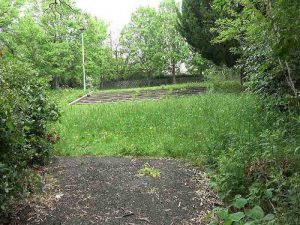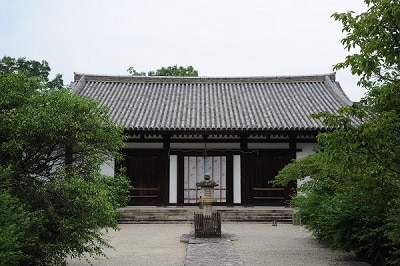Overview
As times moved from the unification of the Northern and Southern Dynasties to the Ohnin War and the political upheaval of the Meio period, Odori Nembutsu (Dancing Prayer), the spread of Buddhism, became a popular folk belief of the common people, accompanied by entertainment (Nembutsu Nagata), and became associated with the Ura Bon festival. It also merged with the Furyu, a flamboyant aspect that caught people by surprise, giving birth to the Bon dance Furyu Odori. This is the origin of Bon Odori.
During this period
This period.
After a period of stability, the Ohnin War and the Myooh political upheaval brought a period of warfare and chaos.
1333 – 1500s
1333: New administration of Kenmu
1336 Opening of the Muromachi Shogunate
1392 Unification of the Northern and Southern Dynasties
1467-1477 Ohnin War
1493 The Meiō Rebellion
Basic Information
Population: Approximately 10 million
Attribute types:Nobles, monks, warriors, peasants, and unrelated persons. More than 80% are peasants. Townspeople who make their living in commerce and industry appear in Kyoto.
Lifespan: About 30 years old
Famine and disaster conditions: Famine, plague, and disaster every 3-5 years
Media of transmission: Aristocrats, warriors, and village rulers only, mainly oral tradition
Domain system: Increased guardian power, shift from manor to local control of nationals.
Common people’s clothing: simple kimonos, cotton and linen
Food of the common people: Mainly Japanese millet, millet, and vegetables
Dwelling of the common people: Thatched dwellings with floor plans
Common people’s entertainment/bon dance opportunities: Kyoto townspeople became the bearers of the Furyu dance
Religion
.
As the Jishu priests accompanied the war to repose the dead, their offerings transformed into a form of consolation through the arts on the battlefield, and combined with the performing arts. This trend led to the formation of Dohoshu, who performed miscellaneous arts at the Shogun’s side.
Bon Odori: Events of these days
From “Dancing Nembutsu” to “Nembutsu Dancing”
The emphasis gradually shifted from the “faith” of Nembutsu to the performance of “dancing”.
It is assumed that there was a boom of “Nenbutsu Odori” (Buddhist prayer dance), which remained in many places.
It is a mistake to think of these changes in the performing arts as a general and uniform phenomenon. There are several areas where the original form of “Odori Nembutsu” is still preserved.
Tendo City, Yamagata Prefecture: Ikkoh Shonin Odori Nenbutsu
Saku City, Nagano Prefecture: Atobe Odori Nembutsu
Fujisawa City, Kanagawa Prefecture: Usu Nenbutsu at Yugyoji Temple
Kyoto City: Kuya Odori Nembutsu (Dancing Nembutsu)
The difference between Odori Nembutsu and Nembutsu Odori lies in whether a Buddhist sect performs Odori Nembutsu to propagate the Nembutsu or whether it is a folk belief and has an element of entertainment while chanting the Nembutsu.
The Emergence of Bon Dancing
The Bon Dancing of the early days was born out of this “Nenbutsu Dancing Boom”. The early Bon dances were born out of this “Nembutsu Odori boom,” or rather, they were just a type of Nembutsu Odori that was danced during the summer season of Obon.
The first recorded sighting of “Bon Odori” was in Fushimi, Kyoto (as described in Kanmon Gyoki). Other early records are from Nara, Kyoto, and the surrounding areas, which were culturally advanced areas.
Early records of Bon Dancing
.
The most characteristic record is a 1469 entry in the “Kyogaku Shiyosho”. It states that the dancers planned to take money for repairing bathtubs by performing the Nenbutsu Fu-ryu dance, built a temporary house, and performed the dance inside it. This could be considered evidence that the Bon festival’s Furyu dances were attractive enough to be viewed and participated in.
| author | Deadline | AD | Content |
|---|---|---|---|
| Prince Fushimi Miyanari | Eiyo July 15th, 3rd | 1431 | Immediate Jin -in Nenbu Logic Example. In some places |
| Kyogakushiyosho | Second year | 1458 | Bon -style dancing in Nara Hitoya City Yori Kaze -style, Tsunagi Kiri Dal Color, (...) Arika, Lung Ya, the next white rain || |
| Kyogakushiyosho | Civilization July 13th | 1469 | Acquisition bath kama training expense that the thirty -e -kan sentence is made by the Nenbutsu -style style box office, and the kariya is built and dancing at that ?. Furuichi -go underground manner for each underground house Define six yen by person to participants from other places |
| Daijoin-Jishazatujiki | Civilization 5th, July 17th | 1473 | Ariyuki Yuko in the style of Wind Ryu. Various performing arts Nonai Furuichi Tanei himself himself |
| Kasuga Shake Ohnakatomi Moroatsu no Shinji Nikki | July 15, 6, 6 | 1497 | Minamito: In recent years (omitted) Introduction to Fuzai -in Tsuji for the first time since yesterday. Every year, the dance of the tray is jumped at Yakushido in the daytime, and at night it is at the Tsuji of Shutsuin. |
Note that this is a fairly urban location. The local records are scarce and not well documented.
It seems, therefore, that it was a performing art that still retained a strong religious nature of Nembutsu belief.
The presence of the phrase “Namu ami dabutsu” in the records of the time indicates this.
Visiting Shin-Yakushiji Temple and Fukuin Tsuji today, “Bon Dancing in History”.

Fushimi Zangetsu Hill, around the ruins of Suiseiin[/caption ]
[caption id="attachment_11783" align="alignright" width="400"] Shin-Yakushiji Temple
Shin-Yakushiji Temple
Fuuryu and Bon Dancing
The Bon dances of this period are also called “furyu hayashi mono.
Glamorous made ups and performances, and “Hayashi” (Odori) among them.
The Bon dance was only a “furyu-hayashi-mono,” and it was not recognized that the center of the performing arts was “dancing”.
Therefore, there are various names for Bon Dancing. Note, however, that they are all “foot flat.
Column: Origin Tradition of Bon Dancing
There is an Origin Tradition of Bon Dancing in each region. They are varied, romantic, and fascinating. Nembutsu Dance Traditions
Plague, war → large number of dead both friend and foe in a short period of time → heavy damage to the community
There are points that cannot be asserted that it was merely a postscript story. It is important to verify the fact.
The origin tradition is often related to the Sengoku Period, when there were many deaths in battle.
The most common explanation is that it is for the repose of the souls of those who died in battle.
The influence of medieval war stories has been pointed out (Gorai).
The prevalence and mutual influence of literature and arts such as Sekkyoh literature
History of Bon Dance
- 0-1 The History of Uraabon
- 0-2 Ancient Japanese customs of the common people (not documented)
- 0-3 Late Heian Period, just before the birth of Bon Dancing
- 1.Kamakura Period Birth of Dancing Nembutsu
- 10.Heisei Reiwa: From Stagnation to the Birth of a New Axis
- 2.Birth of Bon no Furyu Odori (Bon Dance) in the mid-Muromachi Period
- 3.Late Muromachi – Sengoku – Azuchi-Momoyama Rise of Fuuryu Odori and Regional Expansion
- 4.Early Edo Period Establishment of Bon Dancing
- 5.Mid to Late Edo Period Bon Dancing takes root and matures
- 6.Meiji: A Turning Point for Bon Dancing
- 7.Taisho Era – Early Showa Era Revival of Bon Dancing
- 8.Before and After the War Wartime Response, Suspension and Resumption
- 9.Late mid-Showa period Nationwide expansion of Ondo and Minyo (folk songs)
